Contents
Table of Contents
ToggleHow Does Pool Vacuum Work
Are you wondering about how a pool vacuum works? In this article, I’ll provide answers to some frequently asked questions (FAQs) about pool vacuums and their functionality. Understanding how these devices operate can help you maintain a clean and sparkling pool all season long.
Firstly, let’s address the basic question: How does a pool vacuum work? A pool vacuum operates on the principle of suction. It is typically connected to the filtration system of your pool, either through the skimmer or a dedicated suction line. When turned on, water is sucked into the vacuum through its head or brush attachment, along with any debris present in the water.
Pool vacuums come in different types – manual, automatic, and robotic. Manual vacuums require you to manually move them around the pool to clean it thoroughly. Automatic and robotic vacuums are more convenient as they navigate independently across your pool’s surface while efficiently removing dirt, leaves, and other particles.
Now that we’ve covered the basics of how a pool vacuum works, let’s dive into some common FAQs surrounding their operation.

How Does a Pool Vacuum Work?
The Basics of Pool Vacuuming
When it comes to maintaining a clean and sparkling pool, a pool vacuum plays a crucial role. But have you ever wondered how this handy device actually works? Let’s dive into the basics of pool vacuuming.
A pool vacuum operates on the principle of suction. It uses the power of water flow to suck up debris from the pool’s surface and floor. By attaching the vacuum head to a telescopic pole, which can be maneuvered by hand or attached to an automated system, you can effectively clean your pool with ease.
To create suction, most pool vacuums connect to either the skimmer or dedicated suction line in your swimming pool system. As water flows through these lines, it creates a pressure difference that pulls in any dirt, leaves, bugs, or other contaminants that may be present in your pool.
Understanding the Components of a Pool Vacuum
Now that we know how suction is created, let’s take a closer look at the components that make up a typical pool vacuum:
- Vacuum Head: This is the part that directly contacts and cleans the surface and floor of your pool.
- Hose: The hose connects the vacuum head to either an automated cleaning system or manual operation.
- Telescopic Pole: A telescopic pole allows for easy maneuverability while cleaning different areas of your pool.
- Skimmer Basket/Dedicated Suction Line: These are entry points where water enters the vacuum system and carries away debris.
By understanding how each component works together harmoniously, you can ensure efficient and effective cleaning sessions for your beloved swimming oasis.
Step-by-Step Guide to Using a Pool Vacuum
Now that we’ve covered how a pool vacuum functions let’s walk through some simple steps on using one:
- Prepare Your Equipment: Attach the telescopic pole and hose to the vacuum head.
- Prime the Vacuum: Submerge the vacuum head into the pool, allowing water to fill the hose and remove any air pockets.
- Connect the Hose: Attach the other end of the hose to either an automated cleaning system or a suction point in your pool’s filtration system.
- Maneuver and Clean: With everything connected, move the vacuum head across the surface and floor of your pool, ensuring that you cover all areas thoroughly.
- Empty Debris: Periodically check and empty any debris collected in your skimmer basket or dedicated suction line to maintain optimal performance.
Benefits of Using a Pool Vacuum
Using a pool vacuum offers numerous advantages that make it an essential tool for keeping your pool clean and well-maintained. Here are some key benefits to consider:
- Efficient Cleaning: A pool vacuum is designed to efficiently remove debris, leaves, dirt, and other unwanted particles from the bottom and sides of your pool. It saves you time and effort compared to manual cleaning methods like skimming or brushing.
- Improved Water Quality: Regularly using a pool vacuum helps improve the overall water quality by removing contaminants that can lead to cloudy or unhygienic conditions. By eliminating debris and sediment, you’ll have crystal-clear water that’s inviting for swimming.
- Prevents Algae Growth: One of the major benefits of using a pool vacuum is its ability to prevent algae growth. Algae thrive in stagnant water with organic matter present, but by regularly vacuuming your pool, you reduce the chances of algae taking hold and spreading.
- Extends Pool Equipment Lifespan: Debris buildup can damage your pool’s filtration system, pump, and other equipment over time if left unchecked. By using a pool vacuum regularly, you minimise the risk of clogs or malfunctions, thus extending the lifespan of your valuable equipment.
- Cost-effective Maintenance: While investing in a quality pool vacuum may seem like an upfront expense, it can save you money in the long run by reducing maintenance costs. By preventing issues such as clogged filters or damaged equipment, you’ll avoid costly repairs or replacements down the line.
- Enjoyable Swimming Experience: A clean and well-maintained pool not only looks appealing but also provides an enjoyable swimming experience for you and your guests. With a reliable pool vacuum at hand, you can relax knowing that your swimming environment is safe and free from debris.

